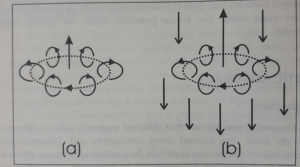Magnetic Materials
In this article I have discussed what are the different types of magnetic materials? and what are the different properties that are associated to them.
Diamagnetism
As we all have the idea that different types of materials behave differently in electric fields. In conductors, charges separate and nullify the field within the inductor. In dielectric materials, atom or molecules rotate or polarize to reduce the electric field.
Similarly, magnetic fields also effects the materials. But as there is no concept of magnetic charges so there is not something called the magnetic conductor. Just like dielectric reacts to electric field, other materials react to the magnetic field.
Magnetic materials usually usually interact with an external magnetic field via dipole rotations at the atomic level. For example, an atom can be considered as dense positive nucleus with electrons of very light weight orbiting around it. It is just like the case of planets orbiting around the sun in solar system.
Another example of the same situation is of a rotating ball tied at the end of a rope. This type of force holds the object in an orbit and acts towards the center of orbit. This force is known as centripetal force. This is conveyed by the electricity, gravitational force and the string tension.

The above figure shows a circulating electron whose magnetic moment is pointing upward and the force due to magnetic field points inward. This force will be added to centripetal force. With the increasing speed, then electron’s magnetic field will also increase which is in opposite direction to the external magnetic field.
As a net effect the orbiting electrons cancel the part of external field. These orbiting electrons changes to oppose the magnetic field just like the free electrons rotate in opposition to a magnetic field. This effect is known as diamagnetism and it is just like that of dielectrics, where dielectric tend to reduce the applied electric field. But diamagnetism is an extremely weak effect. Although all the materials show this effect but it is so weak that mostly it is ignored. This explains why most materials are not that much affected by magnets.
Paramagnetism
Just like the arbitrary motion of electron in an atom, there is a spinning motion too where electrons spin around their axis. Since electrons are charged particles, that’s why this spinning motion causes a circular current and magnetic dipole.
Although we have learned that the currents are determined by the same law of magnetics as for free electrons, they act like in opposite ways.
Hence the inherit dipole of electron will be rotated to line up with external magnetic field, thus resulting in increased field. This phenomenon is called paramagnetism. With paramagnetism, the dipoles line up parallel to external field. This effect is stronger than the diamagnetism but still very weak and hence it can also be ignored.
It is because of the fact that electrons in each atom are always grouped in pairs that spin opposite to one another. hence paramagnetism phenomenon only occurs in those atoms that have odd number of electrons. You can take the example of Aluminum which has atomic number 13 thus there are odd number of electrons. That is why it shows paramagnetism.
Ferromagnetism and Magnets
From the previous understanding we can conclude that diamagnetism and paramagnetism are weaker phenomenon and can be ignored easily. But the effect of ferromagnetism is quite popular and mostly considered. Magnets do exist because of ferromagnetism property. A ferromagnetic material is actually a paramagnetic material with domains featured added in it.
Each domain is a microscopic patch of billions of atoms. Dipole moments of all of them are lined up in the same direction. Specially in case of iron, the quantum mechanical properties cause these domains to form spontaneously.
It is due to the combine effect of spinning motion and collective behavior of outermost electrons of larger groups of atoms. Normally domains are oriented randomly that’s why material does not have overall magnetic dipole.
When we apply an external magnetic field, the domains that are aligned grow and others will shrink. Also these domains have tendency to freeze themselves after they are aligned. So we can say that ferromagnetic materials have memory.
So when you place a bar of a material in a strong magnetic field and then remove it, the bar will retain a net magnetic dipole moment. So it will act like a magnet now.
Some other examples of ferromagnetic materials are nickel and cobalt. Nickel is used in guitar strings. Many metal alloys are also the ferromagnetic materials.
If we expose the ferromagnetic materials to the large electric field, they will retain its effect for a longer period of time. But the terminology used for them is “electret” which are used in certain types of microphones.
How to Demagnetize or Erase the Magnetic Effect?
There are two possible ways to eliminate the magnetic effect from a magnet.
By Heating the Magnet
The first approach is to heat the magnet to its “curie point”. Just like ice melts to water these frozen magnetic moments will vanish. It happens because above this temperature, the material no longer remains a ferromagnetic material.
Exposing Magnet to Strong Electric Field of a Magnet (Degaussing)
This is more appropriate way for demagnetizing the magnet. In this approach magnet is placed in strong AC magnetic field of an electromagnetic (like the solenoid field). This will slowly reduce field to zero and at the end, the material will have negligible magnetic field. This technique is also called “degaussing”.
Also read here
Discuss Certain Phenomenon Where Circuit Theory Fails
How Maxwell’s equations are defined for electrostatics and magnetostatics?